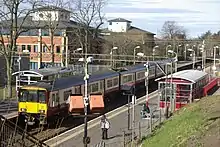Singer | |
|---|---|
 | |
| General information | |
| Location | Clydebank, West Dunbartonshire Scotland |
| Coordinates | 55°54′27″N 4°24′20″W / 55.9075°N 4.4055°W |
| Grid reference | NS497708 |
| Managed by | ScotRail |
| Transit authority | Strathclyde Partnership for Transport |
| Platforms | 2 |
| Other information | |
| Station code | SIN[1] |
| History | |
| Original company | North British Railway |
| Pre-grouping | North British Railway |
| Post-grouping | LNER |
| Key dates | |
| 3 November 1907[2] | Opened legally |
| 4 November 1907[2] | First trains |
| C. 1913[2] | Renamed to Singer for Kilbowie & Radnor Park |
| 1942[2] | Singer Workers Platform opened |
| May 1948[2] | Name reverted to just Singer |
| 1 May 1967[2] | Singer Workers Platform closed |
| Passengers | |
| 2018/19 | |
| 2019/20 | |
| 2020/21 | |
| 2021/22 | |
| 2022/23 | |
| Notes | |
Passenger statistics from the Office of Rail and Road | |
Singer railway station is a two-platformed staffed station serving Clydebank town centre, West Dunbartonshire, Scotland. It is located on the Argyle Line and North Clyde Line between Drumry and Dalmuir, 9 miles 5 chains (14.6 km) from Glasgow Queen Street, measured via Maryhill.[3] All passenger services are provided by ScotRail.
History

Constructed in 1907, Singer station took its name from the large Singer sewing machine factory that it was built to serve.[4][5][6] History of the station within the sewing machine factory is not well-documented. The 'station' inside the factory - and the factory itself - were demolished in or before 1998.[7]
The main station replaced the former Kilbowie station, and soon after opening in 1907, it was renamed to Singer for Kilbowie and Radnor Park, reverting to just Singer some time in May 1948.[8]
Until 2002, Singer was the nearest station to Kilbowie Park, former home of Clydebank F.C. (1965).[9][6]
Passenger volume
| 2002–03 | 2004–05 | 2005–06 | 2006–07 | 2007–08 | 2008–09 | 2009–10 | 2010–11 | 2011–12 | 2012–13 | 2013–14 | 2014–15 | 2015–16 | 2016–17 | 2017–18 | 2018–19 | 2019–20 | 2020–21 | 2021–22 | 2022–23 | |
|---|---|---|---|---|---|---|---|---|---|---|---|---|---|---|---|---|---|---|---|---|
| Entries and exits | 483,400 | 538,634 | 631,782 | 620,534 | 683,374 | 712,904 | 668,796 | 685,080 | 629,626 | 641,210 | 638,418 | 665,536 | 646,864 | 660,346 | 631,430 | 575,008 | 522,712 | 68,590 | 234,144 | 288,890 |
The statistics cover twelve month periods that start in April.
Services

On Mondays-Saturdays, trains between Balloch and Airdrie stop each way every 30 minutes. In addition to these North Clyde Line services, there are two Argyle Line trains per hour between Dalmuir and Larkhall. On Sundays, there is a half-hourly service to Edinburgh via Airdrie and to Helensburgh Central. There is also one train per day from Oban which calls here in the morning peak to Glasgow Queen Street. This operates via Maryhill.[11]
| Preceding station | Following station | |||
|---|---|---|---|---|
| Drumry | ScotRail Argyle Line |
Dalmuir | ||
| Drumry | ScotRail North Clyde Line |
Dalmuir | ||
| Historical railways | ||||
| Drumchapel | North British Railway Glasgow, Dumbarton and Helensburgh Railway |
Dalmuir | ||
References
- ↑ "Railway Codes". railwaycodes.org.uk. Retrieved 27 September 2022.
- 1 2 3 4 5 6 Quick 2022, p. 417.
- ↑ Bridge, Mike, ed. (2017). TRACKatlas of Mainland Britain: A Comprehensive Geographic Atlas Showing the Rail Network of Great Britain (3rd ed.). Sheffield: Platform 5 Publishing Ltd. p. 137. ISBN 978 1909431 26 3.
- ↑ "The Clydebank Story - Transport". Retrieved 11 February 2008.
- ↑ McIntosh Gray & Moffatt 1989.
- 1 2 Butt 1995, p. p=212.
- ↑ "Singer Sewing Machine Factory Kilbowie, Clydebank". www.singersewinginfo.co.uk. Retrieved 24 December 2023.
- ↑ Quick 2022, p. p=264.
- ↑ "Aerial view of Singer". Archived from the original on 10 February 2008. Retrieved 10 February 2008.
- ↑ "Estimates of station usage | ORR Data Portal". dataportal.orr.gov.uk. Retrieved 24 December 2023.
- ↑ eNRT December 2023, Table 206 https://timetables.fabdigital.uk/nrt/dec2023/206%20Glasgow%20to%20Partick,%20Milngavie,%20Yoker,%20Dalmuir,%20Dumbarton,%20Balloch%20and%20Helensburgh.pdf
Bibliography
- Butt, R. V. J. (October 1995). The Directory of Railway Stations: details every public and private passenger station, halt, platform and stopping place, past and present (1st ed.). Sparkford: Patrick Stephens Ltd. ISBN 978-1-85260-508-7. OCLC 60251199. OL 11956311M.
- Jowett, Alan (March 1989). Jowett's Railway Atlas of Great Britain and Ireland: From Pre-Grouping to the Present Day (1st ed.). Sparkford: Patrick Stephens Ltd. ISBN 978-1-85260-086-0. OCLC 22311137.
- McIntosh Gray, Alastair and Moffat, William (1989). A History of Scotland. Oxford: Oxford University Press. ISBN 0-19-917063-0.
- Quick, Michael (2022). Railway Passenger Stations in Great Britain: A Chronology (PDF) (5th ed.). London: Railway and Canal Historical Society.
- Yonge, John (May 1987). Gerald Jacobs (ed.). British Rail Track Diagrams - Book 1: ScotRail (1st ed.). Exeter: Quail Map Company. ISBN 0-9006-0948-6.
- Yonge, John (February 1993). Gerald Jacobs (ed.). Railway Track Diagrams - Book 1: Scotland and the Isle of Man (2nd ed.). Exeter: Quail Map Company. ISBN 0-9006-0995-8.
- Yonge, John (April 1996). Gerald Jacobs (ed.). Railway Track Diagrams - Book 1: Scotland and the Isle of Man (3rd ed.). Exeter: Quail Map Company. ISBN 1-8983-1919-7.
- Yonge, John (2007). Gerald Jacobs (ed.). Railway Track Diagrams - Book 1: Scotland & Isle of Man (Quail Track Plans) (fifth ed.). Bradford on Avon: Trackmaps (formerly Quail Map Co). ISBN 978-0-9549866-3-6. OCLC 79435248.
External links
- RAILSCOT on Glasgow, Dumbarton and Helensburgh Railway
- Train times and station information for Singer railway station from National Rail